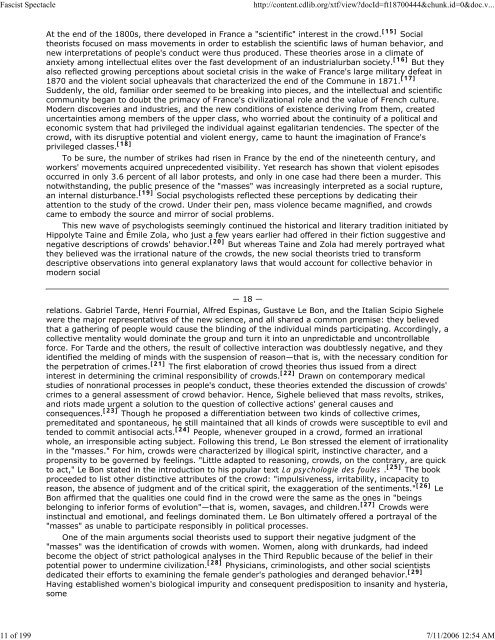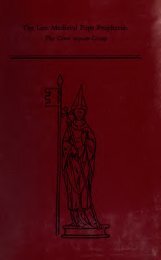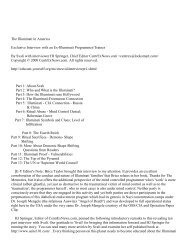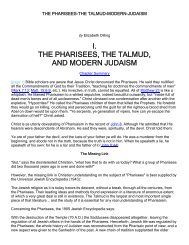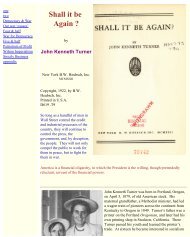You also want an ePaper? Increase the reach of your titles
YUMPU automatically turns print PDFs into web optimized ePapers that Google loves.
<strong>Fascist</strong> <strong>Spectacle</strong> http://content.cdlib.org/xtf/view?docId=ft18700444&chunk.id=0&doc.v...<br />
At the end of the 1800s, there developed in France a "scientific" interest in the crowd. [15] Social<br />
theorists focused on mass movements in order to establish the scientific laws of human behavior, and<br />
new interpretations of people's conduct were thus produced. These theories arose in a climate of<br />
anxiety among intellectual elites over the fast development of an industrialurban society. [16] But they<br />
also reflected growing perceptions about societal crisis in the wake of France's large military defeat in<br />
1870 and the violent social upheavals that characterized the end of the Commune in 1871. [17]<br />
Suddenly, the old, familiar order seemed to be breaking into pieces, and the intellectual and scientific<br />
community began to doubt the primacy of France's civilizational role and the value of French culture.<br />
Modern discoveries and industries, and the new conditions of existence deriving from them, created<br />
uncertainties among members of the upper class, who worried about the continuity of a political and<br />
economic system that had privileged the individual against egalitarian tendencies. The specter of the<br />
crowd, with its disruptive potential and violent energy, came to haunt the imagination of France's<br />
privileged classes. [18]<br />
To be sure, the number of strikes had risen in France by the end of the nineteenth century, and<br />
workers' movements acquired unprecedented visibility. Yet research has shown that violent episodes<br />
occurred in only 3.6 percent of all labor protests, and only in one case had there been a murder. This<br />
notwithstanding, the public presence of the "masses" was increasingly interpreted as a social rupture,<br />
an internal disturbance. [19] Social psychologists reflected these perceptions by dedicating their<br />
attention to the study of the crowd. Under their pen, mass violence became magnified, and crowds<br />
came to embody the source and mirror of social problems.<br />
This new wave of psychologists seemingly continued the historical and literary tradition initiated by<br />
Hippolyte Taine and Émile Zola, who just a few years earlier had offered in their fiction suggestive and<br />
negative descriptions of crowds' behavior. [20] But whereas Taine and Zola had merely portrayed what<br />
they believed was the irrational nature of the crowds, the new social theorists tried to transform<br />
descriptive observations into general explanatory laws that would account for collective behavior in<br />
modern social<br />
― 18 ―<br />
relations. Gabriel Tarde, Henri Fournial, Alfred Espinas, Gustave Le Bon, and the Italian Scipio Sighele<br />
were the major representatives of the new science, and all shared a common premise: they believed<br />
that a gathering of people would cause the blinding of the individual minds participating. Accordingly, a<br />
collective mentality would dominate the group and turn it into an unpredictable and uncontrollable<br />
force. For Tarde and the others, the result of collective interaction was doubtlessly negative, and they<br />
identified the melding of minds with the suspension of reason—that is, with the necessary condition for<br />
the perpetration of crimes. [21] The first elaboration of crowd theories thus issued from a direct<br />
interest in determining the criminal responsibility of crowds. [22] Drawn on contemporary medical<br />
studies of nonrational processes in people's conduct, these theories extended the discussion of crowds'<br />
crimes to a general assessment of crowd behavior. Hence, Sighele believed that mass revolts, strikes,<br />
and riots made urgent a solution to the question of collective actions' general causes and<br />
consequences. [23] Though he proposed a differentiation between two kinds of collective crimes,<br />
premeditated and spontaneous, he still maintained that all kinds of crowds were susceptible to evil and<br />
tended to commit antisocial acts. [24] People, whenever grouped in a crowd, formed an irrational<br />
whole, an irresponsible acting subject. Following this trend, Le Bon stressed the element of irrationality<br />
in the "masses." For him, crowds were characterized by illogical spirit, instinctive character, and a<br />
propensity to be governed by feelings. "Little adapted to reasoning, crowds, on the contrary, are quick<br />
to act," Le Bon stated in the introduction to his popular text La psychologie des foules . [25] The book<br />
proceeded to list other distinctive attributes of the crowd: "impulsiveness, irritability, incapacity to<br />
reason, the absence of judgment and of the critical spirit, the exaggeration of the sentiments." [26] Le<br />
Bon affirmed that the qualities one could find in the crowd were the same as the ones in "beings<br />
belonging to inferior forms of evolution"—that is, women, savages, and children. [27] Crowds were<br />
instinctual and emotional, and feelings dominated them. Le Bon ultimately offered a portrayal of the<br />
"masses" as unable to participate responsibly in political processes.<br />
One of the main arguments social theorists used to support their negative judgment of the<br />
"masses" was the identification of crowds with women. Women, along with drunkards, had indeed<br />
become the object of strict pathological analyses in the Third Republic because of the belief in their<br />
potential power to undermine civilization. [28] Physicians, criminologists, and other social scientists<br />
dedicated their efforts to examining the female gender's pathologies and deranged behavior. [29]<br />
Having established women's biological impurity and consequent predisposition to insanity and hysteria,<br />
some<br />
11 of 199 7/11/2006 12:54 AM


